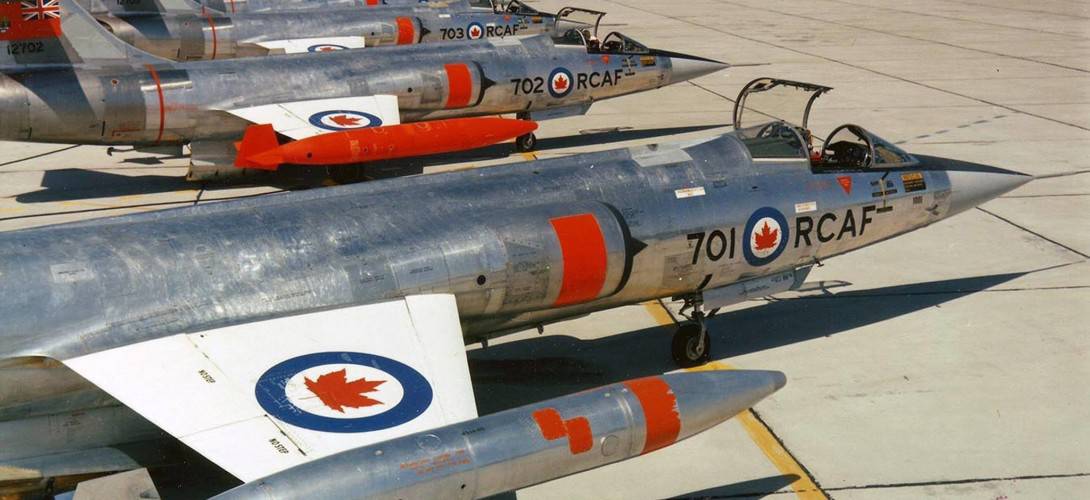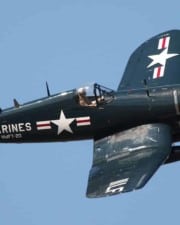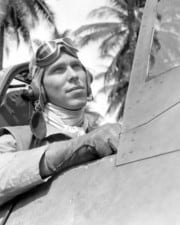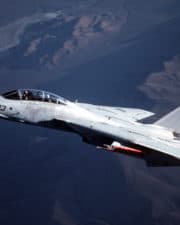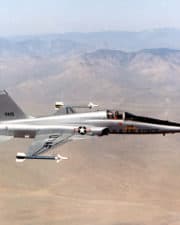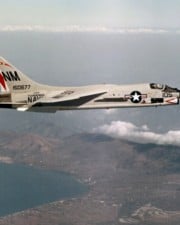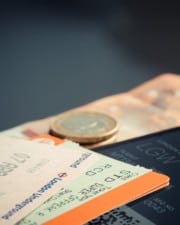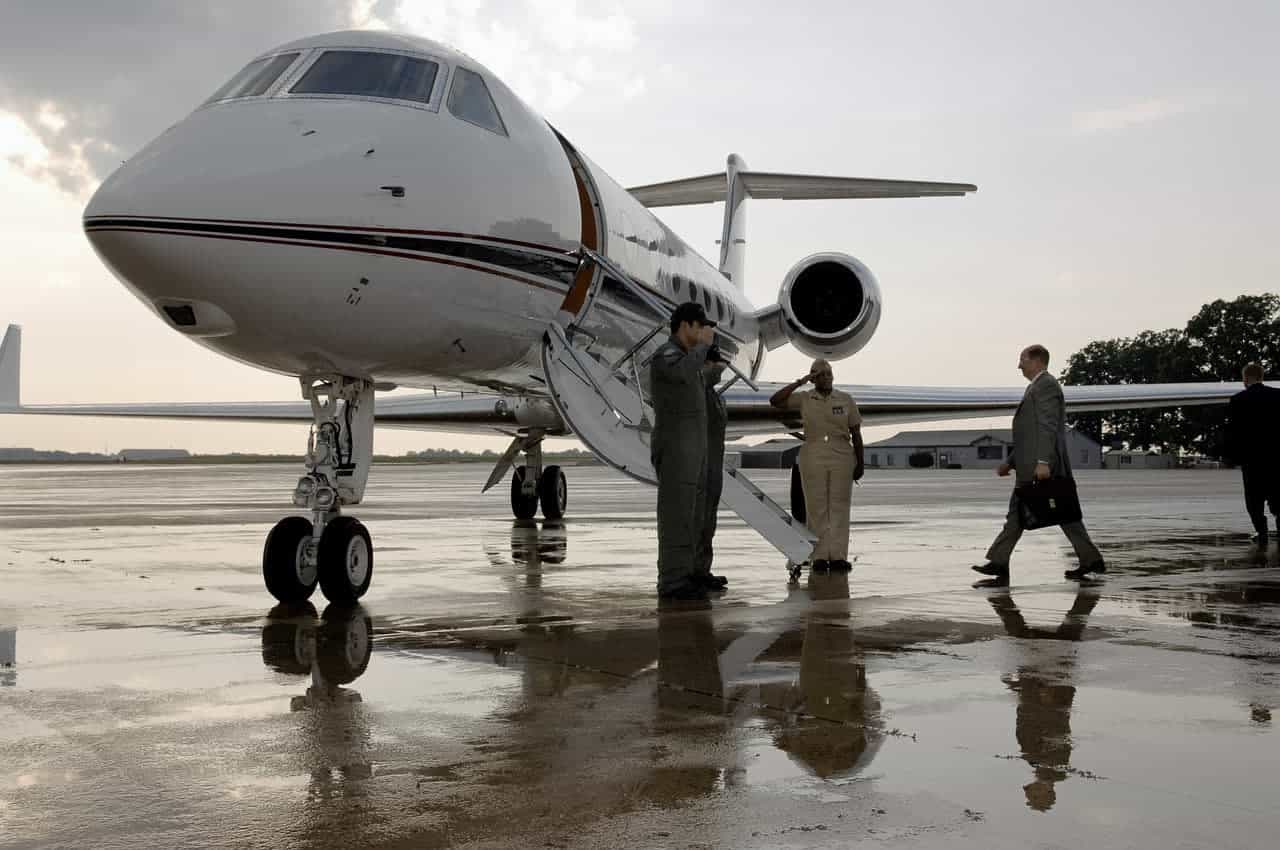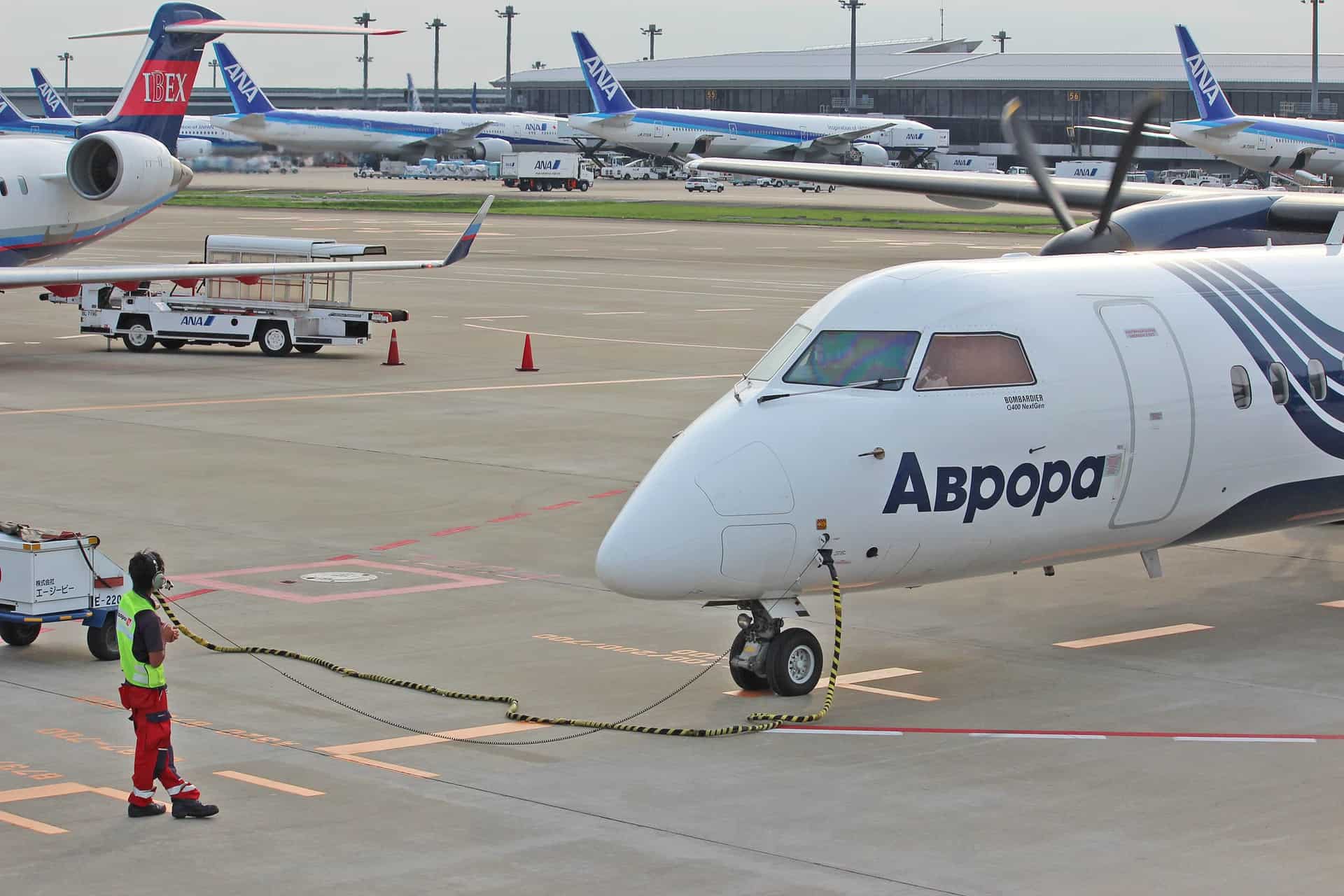From its service in Operation Friction to dazzling aerial shows to its place in the Canadian economy, the Royal Canadian Air Force has served valiantly in the decades since its inception. These jets have done the Great White North proud.
Far too often, it’s forgotten that Canada entered WWII before America, such is the shadow cast over it by its large and more militant North American neighbor. The same may be said for the Royal Canadian Air Force, which is all too often overshadowed by the USAF and RAF.
That is due in part to the fact that Canada actually buys a lot of its jets from both of those close allies. There is also the fact that Canada has a strong and welcome reputation for peace.
Why should that matter? Because while the United States and United Kingdom have routinely found themselves in wars from Korea and Vietnam to the Suez and the Falklands, Canada has enjoyed relative peace over the decades.
However, as its proud WWII heritage demonstrates, Canada knows how “to stand on guard for thee” when need be. Its role in the Gulf War, for example, demonstrated great skill on the part of its jet pilots.
Jet production and aerial tradition is also a key part of certain provinces’ economies, such as Alberta and Manitoba.
What’s interesting is, a number of military jets in service with Canada were American models by Lockheed and NAA that were manufactured in Canada by Canadair.
In this article we take a look at the top Canadian fighter jets that served the RCAF throughout history, as well as some trainer and utility jets in service with Canada’s Air Force.
Table of Contents
1. McDonnell Douglas CF-18 Hornet

The backbone of the Royal Canadian Air Force’s fighter jet complement today, the CF-18 Hornet is an example of Canadian and American cooperation. For fans of the Winnipeg Jets, the CF-18 is also recognizable as the team’s fantastic logo since the franchise was reborn in 2011.
The F-18 has flown missions in Kosovo, Afghanistan, and Iraq, flown over Libya during the Civil War, and run counter-ISIS operations. Canada itself flew CF-18s while participating in Operation Friction (the Canadian front of Operation Desert Storm), which was the first case of Canadian military intervention since the Korean War.
The CF-18 Hornet measures 56 feet, can reach a maximum speed of 1,127.2 mph, has an operational range of 330mi, and is armed with 1×20mm M61A1 Vulcan Gatling gun and up to 13,700 pounds of rockets, laser-guided bombs, and Sidewinder, Sparrow, and Maverick missiles.
2. McDonnell Voodoo CF-101

Another fighter jet that found its way into the RCAF and also the United States Air Force, the Voodoo didn’t have as long of a career as other jets. Still, it saw USAF use during the Cuban Missile Crisis and Vietnam War.
For much of its run, Canada was the only foreign buyer of the US-made Voodoo. They were used by 425 and 416 Squadrons, and many were traded back to the United States as US models under Operation Peace Wings, though many remain on display throughout Canada today.
The Voodoo measured 67 feet 5 inches, was powered by 2×Pratt & Whitney J57-P-55 afterburning turbojets to a maximum speed of 1134 mph, and could carry 2xAIR-2A Genie unguided nuclear rockets with a 1.5 Kt warhead (provoking a nuclear controversy at the time in Canada) and 2xAIM-4D Falcon heat-seeking air-to-air missiles.
3. Canadair Starfighter CF-104

A modified version of the Lockheed CF-104 Starfighter used by the USAF, which was manufactured in Canada by Canadair instead, this model was another fighter jet that was outfitted in such a way as to be able to carry nuclear weapons in the event of a strike.
While some nicknamed the Starfighter the “Widowmaker,” pilots could be a little less complimentary, calling it the “Aluminium Death Tube” and “The Lawn Dart.” Still, the Starfighter was reported to score well during NATO exercises, with Canada participating in the AFCENT Tactical Weapons competition in 1964 and other competitions afterward.
The Starfighter measured 54 feet 6 inches, could obtain maximum speeds of 1146 mph via 1×Orenda J79-OEL-7 afterburning turbojet, had an operational range of 1630 miles, and was armed with 1×20mm M61A1 Vulcan cannon and various types of bombs, missiles, and rockets.
4. Canadair Sabre
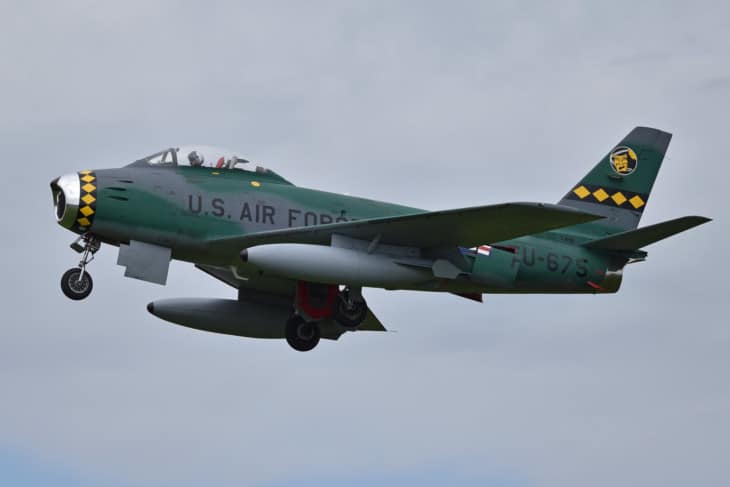
Another example of the RCAF taking an American design (this time the F-86 Sabre) and making it their own with a Canadair version, the Sabre was predominantly operated out of Manitoba, another reason why the Winnipeg Jets’ nickname and logo are incredibly appropriate in honoring Canada’s great jet-fueled aviation legacy.
Though it was never a fighter jet in its own right, the Sabre was the primary training jet for the RCAF until 2000. It has also been flown by the Snowbirds aerial acrobatics team, with these models featuring slight modifications to give them enhanced performance compared to the usual model.
The Sabre measures 32 feet; had an empty weight of 4840 pounds, gross weight of 7348 pounds, and maximum takeoff weight of 11,000 pounds; had a 944-mile range; and had a maximum speed of 486mph powered by a 1×Orenda J85-CAN-40 turbojet.
5. Canadair CT-114 Tutor

Not a fighter per se but rather a training jet used to help get Canadian pilots ready for the real thing, this is yet another example of Canadair’s plane manufacturing power on display. Outside Canada, Embry-Riddle Aeronautical University, located in Daytona Beach, has a CT-114 Tutor courtesy of John Travolta.
The Tutor was also another training jet that was used for aerobatic displays, with a 1967 delivery of ten Tutors for this purpose being one of the high points here, as the aerobatics team the Golden Centennaires celebrated Canada’s centennial by doing just that.
The CT-114 Tutor measured 32 feet, had an empty weight of 4840 pounds, a gross weight of 7348 pounds, a maximum takeoff weight of 11,000 pounds, a range of 944 miles, and a maximum speed of 486mph obtained by a 1×Orenda J85-CAN-40 turbojet.
6. Avro Canada CF-100 Canuck
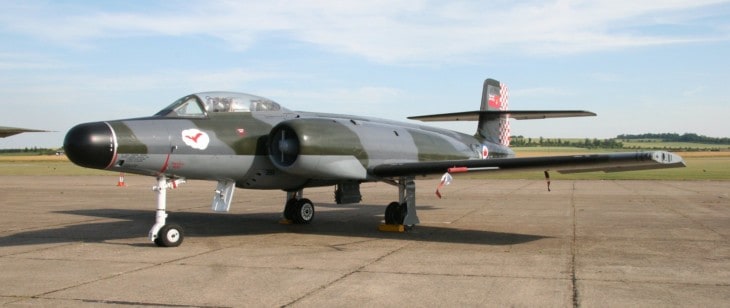
The Canuck has had plenty of unflattering nicknames over the years, from the “Clunk” and the “Lead Sled” to the “CF-Zero” and “Zilch.” The indignities don’t stop there, as the USAF actually considered and rejected the CF-100 for duty in the Vietnam War for perceived shortcomings.
However, the CF-100 still found a home with nine different RCAF squadrons throughout the 1950s. Four of these were sent over to Europe as part of the Nimble Bat program, to be replaced with the Canadair Sabre, which was perceived as providing better all-weather defense against would-be Soviet fighters.
The Canuck measured 54 feet 2 inches, was powered by 2×Avro Canada Orenda 11 turbojet engines to a maximum speed of 552mph, had an operational range of 2000 miles, had an empty weight of 23,100 pounds and gross weight of 33,450 pounds, and was armed with 29x70mm “Mighty Mouse” rockets.
7. BAE Systems Hawk

Another trainer jet, both the Royal Canadian Air Force and the Royal Air Force use this model, a testament to the lasting bond between these Commonwealth countries. The RAF used them in their famed Red Arrows aerobatics team from 1979, while the RCAF used them as yet another trainer jet.
The RAF and RCAF aren’t alone in using this jet; on the contrary, it’s one of the most prolific models on this list. In addition to the RAF and RCAF, it has also found its way into the Finnish, Indian, Saudi, Indonesian, Malaysian, and Zimbabwean air forces.
The BAE Systems Hawk measures 40 feet 9 inches, can attain a maximum speed of 638mph with a 1×Rolls-Royce Turbomeca Adour Mk. 951 turbofan, and can be armed with a 1×30mm ADEN cannon, Sidewinder, ASRAAM, or A-Darter missiles, and Umbani or Al Tariq precision-guided bombs.
8. de Havilland Vampire
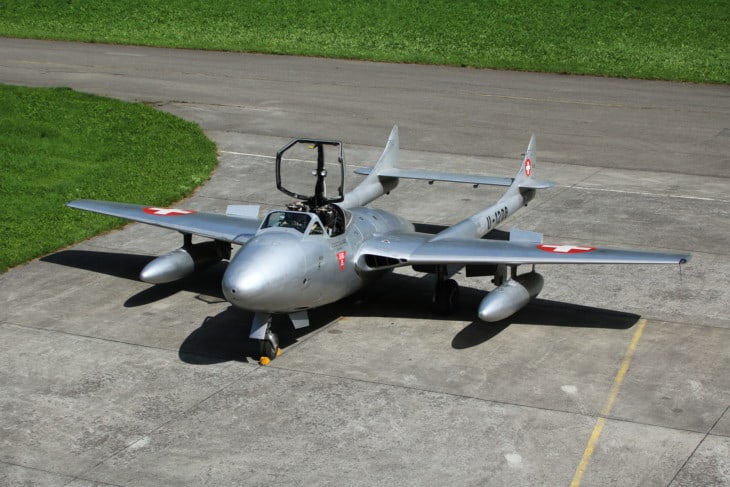
Another example of a fighter jet crossing over for use by both the RAF and RCAF right after WWII, the de Havilland Vampire is a well-traveled fighter jet. It was also used by other militaries in various capacities, including the Egyptian, Rhodesian, Italian, Indian, Norwegian, Swedish, and Swiss air forces.
In Canada, the Vampire was one of two jet fighters flown at the Central Flying School in 1948 for training purposes. With a total of 86 Vampires, it became the first fighter jet used by the RCAF in large numbers before being retired for the Sabre in the late 1950s.
The de Havilland Vampire measured 30 feet 9 inches, could attain a maximum speed of 548mph with a 1×de Havilland Goblin 3 centrifugal-flow turbojet engine, had a range of 1220 miles, and could be armed with 4×20 mm Hispano Mk.V cannons, rockets, and bombs.
9. de Havilland Canada DHC-6 Twin Otter

This utility jet has been in production since the late 1980s and is currently produced by Viking Air. While they fell out of favor for a while, they resumed production in 2010, and by 2017 had sold an impressive 125, and had been delivered them to 34 countries by that point.
What’s more, the de Havilland DH-6 Twin Otter has been a significant part of the Canadian airplane production industry. For example, when production resumed, it resulted in more work at an assembly plant in Calgary, yet another city connected to Canada’s proud aerial tradition.
The de Havilland Canada DHC-6 Twin Otter measures 49 feet 6 inches, can carry a payload of 3031 pounds, and has a max cruising speed of 209mph. It has also been used by commercial skydiving teams as well as for medical evacuation and cargo transportation purposes.
Related Posts
